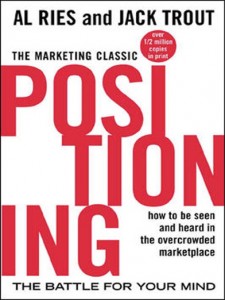Another book review this week, this time Positioning by Al Ries and Jack Trout.
Obviously this is a book that had been around a long time. And there are endless reviews, over the years with different opinions. However, what’s interesting from skimming through the Amazon reviews, is that there’s a real mix between people who think the book is genius and those that think it’s just not relevant today, as it was 30 years ago. And there are a few examples of one of the most cutting remarks that can be made about a marketing textbook – that it’s good for students but not “relevant in the real world”.
I do think it’s a great book, and still just as relevant today as it was 30 years ago. In fact, I’d argue, it’s more relevant.
Like all great marketing books it has, at its core, an extremely simple message. Rather than paraphrase, I’ll quote verbatim:
Positioning starts with a product. A piece of merchandise, a service, a company, an institution, or even a person. Perhaps yourself. But positioning is not what you do to a product. Positioning is what you do to the mind of the prospect. That is, you position the product in the mind of the prospect.There then follows a lot of detail filling in what this really means, for example:
- That you need to position your product to link with what’s already in your customers’ minds. You can’t create new ideas in peoples’ minds, so you have to link your product to what’s already there. And you can’t change peoples’ minds.
- Today’s marketplace is so over-crowded with products and messages that, unless you come up with a massively over-simplified idea, your message just won’t get through.
- You have to start from how your prospects view the market and what your competition are doing. You then try and position your product using this “outside-in” approach (“How do we fit in that market?”) rather than an “inside-out” approach (where you start with your product and try to figure out “How can we sell this?”)
- You need to find the hole (or “Cherchez le creneau”) in the market which, although simple in concept, is actually the hardest part of the process. Why? Because if something was obvious (“Why don’t we create an online storage service?”), then someone else has already done and will be first in the market (and if you’re first to be successful in a market, then that’s a hard position for others to overtake).
But there are a few things that I particularly like about the book and why I think it’s even more interesting than perhaps it was a few decades ago. Firstly, as they point out, “We live in an over-communicated society”. Well if that were true in the early 80s, it’s even worse now. The low barrier to entry required to get any new product off the ground (or even a pseudo-product with a honeypot landing page) means that there are often hundreds of products out there in a similar category to yours, with the budget and knowledge to get their message out there. How on Earth can you get yourself heard over that din? Going back to the very simple task of “How do I differentiate against the rest of the market? How am I unique? Why would anybody out there want this instead of all of them?” seems an almost necessary task to undertake before moving on to more detailed, tactical marketing methods.
Secondly though, and I think the reason why I found the book so useful, is that any search for “Marketing books”, “Marketing blogs” or “Marketing conferences” today brings back a series of results almost exclusively around the areas of lead generation, SEO, PPC, content marketing, funnel optimisation, lead nurturing and so on. Obviously, all of these are vital in the world of digital marketing. But these go hand in hand with the upfront basic work of figuring out your position, your message, and what you’re trying to sell. Your content marketing campaign will struggle if you don’t know what the proposition is that you’re trying to market – and hence what you should be writing content about!
Another comment made about the book is that’s only relevant with big advertising budgets, for big brands. It’s certainly true that most of the examples provided are for brands that everyone will have heard of. But, I think this point is perhaps less relevant today – 20 years ago you needed significant budget to make any sort of splash. But that’s not the case so much now. With content marketing via blogs, and other mechanisms, there are other ways to get your message out (though obviously budget is still needed for other channels).
The last point I’d make is that I really like the emphasis on the point that forcing yourself to stick to the more rigid approach of assessing the market (looking from the “outside-in”) and trying to “find the hole” makes the job more simple (you know what you need to do first), but really more difficult. This forces us to raise the bar for new ideas and pay much closer attention to those that we think are great and assess them against much stricter criteria. It really doesn’t matter if you come up with great idea, even a fully-coded great product, if that space is already taken. Just saying “But ours will be better!” is wishful thinking that could cost you dearly.
